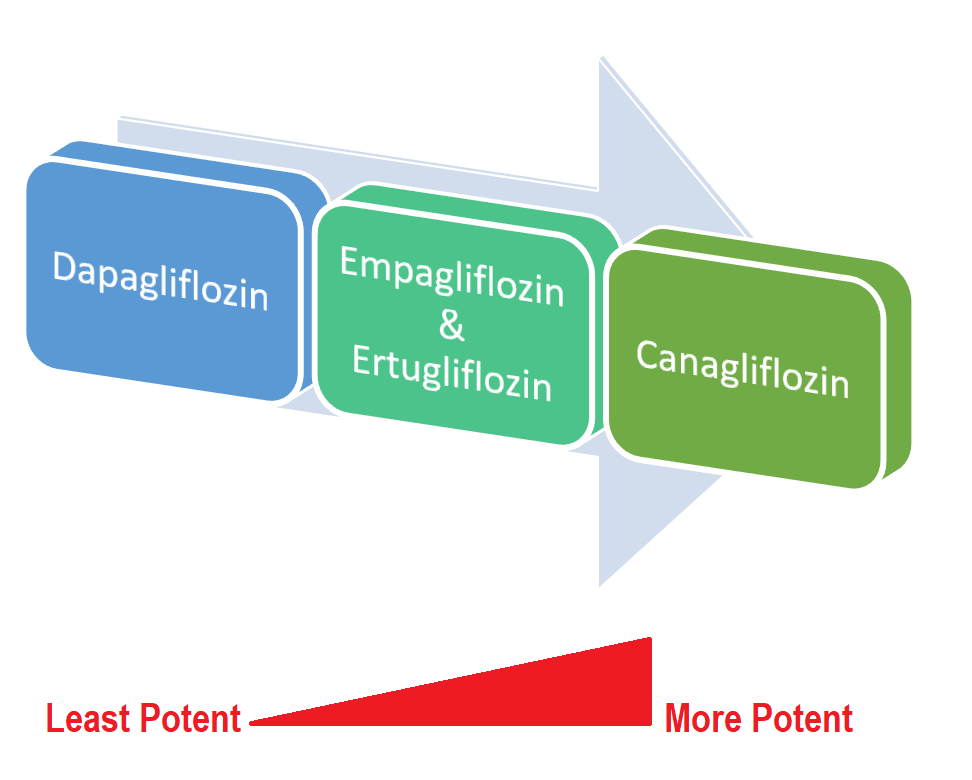Jardiance and Farxiga are the two most commonly prescribed SGLT2 Inhibitors.
Like ACE Inhibitors, antihypertensives, and other diabetes medications, there are similarities and differences between Jardiance and Farxiga, although both drugs belong to the same class of medicines.
Jardiance contains Empagliflozin while Farxiga contains Dapagliflozin. Both these drugs are called the SGLT2 Inhibitors or the “flozins”.
Other drugs from the same class of medicines include:
- Canagliflozin (Invokana)
- Ertugliflozin (Steglatro), and
- Sotagliflozin (Zynquista)
Empagliflozin (Jardiance), Dapagliflozin (Farxiga), Canagliflozin (Invokana), and Ertugliflozin (Steglatro) primarily inhibit SGLT2 receptors.
Sotagliflozin (Zynquista), on the other hand, is a dual SGLT1 and SGLT2 receptor inhibitor.
The MOA of Jardiance Vs Farxiga:
Both Jardiance and Farxiga are from the same class of medicines called SGLT2 Inhibitors (Sodium-glucose co-transporter 2 Inhibitors).
All SGLT2 inhibitors, including Jardiance and Farxiga, lower blood glucose by inhibiting glucose reabsorption from the renal tubules back into the plasma.
In nondiabetic individuals, the kidneys filter 180 g of glucose per day. 90% of the 180 gms is reabsorbed back into the plasma via SGLT2 receptors present in the renal tubules.
This is equivalent to 162 g of glucose that is reabsorbed back into the plasma.
The amount of glucose that is filtered in patients with diabetes is variable and depends on the plasma glucose, but is much greater than 162 gms. This could be as much as 13000 mg per day [Ref].
When glucose reabsorption is inhibited, more of it is lost in the urine. This has a direct blood-glucose-lowering effect.
However, it has been seen that Jardiance more effectively blocks SGLT2 receptors compared to Farxiga (Dapagliflozin). Empagliflozin is almost twice as specific for SGLT2 receptors as Dapagliflozin.
Empagliflozin is 2500 times more selective for SGLT2 receptors compared to SGLT1 receptors, while Dapagliflozin is 1200 times more specific for SGLT2 receptors compared to SGLT1 receptors [Ref]
Because of the strong receptor selectivity, Jardiance (Empagliflozin) is considered more effective in the treatment of diabetes mellitus compared to dapagliflozin.
Jardiance | Farxiga | |
| Generic | Empagliflozin | Dapagliflozin |
| In combination with other diabetes medications |
|
|
| Dose | 10 mg once daily up to a maximum dose of 25 mg once daily | 5 mg once daily up to a maximum of 10 mg once daily |
| Bioavailability | 78% | 78% |
| Time to peak concentration | 1.5 hours | 2 hours |
| Half-life elimination | 12.9 hours | 12.2 hours |
Jardiance vs Farxiga Efficacy in T2DM:
Jardiance and Farxiga are effective SGLT2 Inhibitors. Because of their receptor specificity, there are slight differences in their efficacies. Jardiance more specifically binds SGLT2 receptors compared to Farxiga.
Among the SGLT2 Inhibitors, Canagliflozin (Invokana) is considered the most potent in terms of reduction in glycated hemoglobin, followed by Ertugliflozin (Steglatro) and Empagliflozin (Jardiance) followed by Dapagliflozin (Farxiga).

The reduction in HbA1C with any of the SGLT2 Inhibitors is very much dependent on the baseline HbA1C of the patients.
Jardiance lowers the HbA1C by -0.7 to -0.9% from a baseline HbA1C of 8%. Farxiga lowers the HbA1C by -0.5% to -0.7% from a baseline HbA1C of 7.7%.
The reduction in HbA1C in relation to the baseline HbA1C is given in the table below [Ref]:
Farxiga (Dapagliflozin) | Jardiance (Empagliflozin) | |||
| Baseline HbA1C | Reduction in HbA1C | Baseline HbA1C | Reduction in HbA1c | |
| Monotherapy | 7.8 – 8% | -0.8 to -0.9% | 7.9% | -0.7% to -0.8% |
| In combination with Metformin | 9.1% | -2% | 7.9% | -0.7% to -0.8% |
| 7.7% | -0.5% | 8.7% -8.8% | -1.9% to 2.1% | |
| In combination with Glimepiride | 8.1% | -0.6% – -0.8% | ||
| In combination with Metformin and Sulfonylurea | 8.08% | -0.86 | 8.1% | -0.8% |
| In combination with thiazolidinediones | 8.4% | -0.8% to -1% | 8.1% | -0.6% to -0.7% |
| In combination with DPP-IV Inhibitors (Sitagliptin with or without metformin) | 7.90% | -0.45% | ||
| In combination with Insulin with or without 2 or more oral antidiabetic drugs | 8.6% | -0.8% to -0.9% | 8.3% | -0.6% – -0.7% |
| 8.3% to 8.4% | -0.9% to -1% | |||
Jardiance vs Farxiga in patients with heart failure:
Both Jardiance (Empagliflozin) and Farxiga (Dapagliflozin) have been found to be superior to placebo in patients with heart failure and reduced ejection fraction (HFrEF) regardless of whether they have diabetes or not.
The DECLARE-TIMI demonstrated a 27% reduction in heart failure in the Farxiga (Dapagliflozin) group compared to the placebo.
The EMPAREG Outcome trial demonstrated a 35% reduction in heart failure compared to the placebo.
| Jardiance in the EMPA-Reg Trial | 35% ⇓ |
The EMPA-Reduced trial demonstrated the superiority of Jardiance compared to placebo in terms of the primary outcome (19.4% vs 24.7%) [Ref]:
- Cardiovascular death (10% vs 10.8%)
- Hospitalization due to heart failure (13.2% vs 18.3%)
Jardiance (but not Farxiga) has also been studied in patients with heart failure and preserved ejection fraction (HFpEF).
Jardiance demonstrated a significant reduction in cardiovascular deaths and hospitalization due to heart failure compared to placebo (13.8% vs 17.1%) (P <0.001) [Ref].
Farxiga (dapagliflozin) is being studied in the DELIVER Trial. The trial will evaluate the role of Farxiga in patients with heart failure with a preserved ejection fraction. However, previous data have not supported its use.
Jardiance vs Farxiga in patients with Kidney disease:
SGLT2 Inhibitors have been shown to reduce proteinuria and the progression to end-stage renal disease. The protective effects of Jardiance and Farxiga are thought to be the result of multiple mechanisms. These include:
- reduction in glycated end products as a result of improvement in diabetes
- reduction in glomerular pressure, and hyperfiltration
- Improvement in blood pressure and intravascular volume.
The results of Jardiance and Farxiga on kidney function and microalbuminuria are variable. In some studies, empagliflozin has been shown to lower urinary microalbuminuria better than dapagliflozin.
In other studies, dapagliflozin has been shown to be superior in terms of the progression to end-stage renal disease.
However, it should be noted that patient selection is one of the major factors that could have caused the differences.
Patients in the Empagliflozin group had more advanced kidney disease compared to those in the dapagliflozin group [Ref].
Once kidney functions start declining, the progression is more rapid. Hence, patients treated with Jardiance had more rapid disease progression compared to Farxiga.
Jardiance is contraindicated in patients with an eGFR of less than 30 ml/minute, while Farxiga can be given to patients until the eGFR drops to less than 15 ml/minute.
Jardiance vs Forxiga in patients with T1DM:
Like all SGLT2 Inhibitors, Jardiance and Farxiga are associated with euglycemic ketoacidosis. The risk of developing euglycemic ketoacidosis is much higher in patients with T1DM.
However, since SGLT2 inhibitors have a distinct mechanism of action, it has been studied in patients with T1DM. The results of the two most important clinical trials are presented here in the table below:
Jardiance Vs Forxiga in T1DM | ||
Jardiance | Farxiga | |
| Trials | EASE Trial | DEPICT Trial |
| Dosage used | 2.5 mg, 10 mg, and 25 mg | 5 mg and 10 mg |
| HbA1C Reduction | 0.5% after 26 weeks | 0.4% after 52 weeks |
| Reduction in Weight | 3 Kgs | 3 kgs |
| Other Comments | Improvement was noted even when Jardiance was used in doses as low as 2.5 mg per day. | Forxiga got approval from NICE for use in a subset of stable and obese patients with T1DM. However, recently, the approval for the use of Farxiga in T1DM has been withdrawn. |
Jardiance vs Farxiga for Weight Loss:
SGLT2 Inhibitors cause the excretion of glucose from the body via urine. The more glucose is lost, the greater the weight loss.
Theoretically, it can cause significant weight loss. However, in clinical trials, and because of some compensatory mechanisms, the average weight loss in most studies has been around 3 to 6 kgs after 26 to 52 weeks.
Both Jardiance and Farxiga are associated with weight loss. In one trial, the weight loss effect of Farxiga was sustained compared to Jardiance [Ref].
Jardiance vs Farxiga in patients with Fatty Liver and NASH:
Jardiance and Forxiga have been shown to favorably alter the progression of fatty liver and NASH. Few trials have been conducted, however, there hasn’t been any direct comparison of the two drugs in NASH and fatty liver.
The outcomes of two clinical trials are tabulated here:
Empagliflozin vs Dapagliflozin in patients with NASH | ||
Jardiance | Farxiga | |
| Combined with | None | Exenatide and Omega-3 fatty acids |
| Outcome | Liver fibrosis and a 2.3-fold reduction in liver fat content | Improvement in Liver enzymes, HbA1C, Cytokeratin, and fibroblast growth factor |
Other Similarities between Jardiance and Farxiga:
Jardiance and Farxiga have similar side effect profiles. In our clinical practice, both drugs are associated with urinary tract infections, however, the incidence of UTI is somewhat less in patients using Farxiga compared to Jardiance. This might be just a coincidence.
Both Jardiance and Farxiga are Category C drugs in Pregnancy and should ideally be avoided in pregnant female patients.
Like all other SGLT2 Inhibitors, Jardiance and Farxiga are also associated with an increase in LDL (low-density lipoprotein) cholesterol levels.
- Berberine 1200 mg Plus Ceylon Cinnamon 100 mg, 120 Veggie Capsules – Introducing NutriFlair Berberine Supplements with 1…
- Berberine Hydrochloride (HCL) is a compound found in several plants, including goldenseal, barberry, oregon grape, and t…
- Vegan, Non-GMO, Gluten-free – Our Doctor formulated Berberine with Ceylon Cinnamon capsules, is made with 100% Natural, …
- FULL SPECTRUM OF BENEFITS TO SUPPORT BLOOD SUGAR HEALTH: (1) Supports healthy blood sugar levels, (2) Supports healthy w…
- SUPPORTS THE 3 ESSENTIALS FOR HEALTHY BLOOD SUGAR: Sugar absorption, sugar production, and sugar usage. Only Glucocil ta…
- SOFTGELS FOR EFFICIENT ABSORPTION (*2,250mg OF ACTIVE INGREDIENTS PER SERVING): Doctor formulated, proprietary blend, 14…

- [Large Storage Space] The insulin cooler travel case can easily hold up to 7 insulin pens, blood glucose monitor and oth…
- [Best Insulation] The insulin travel case is made of EVA patch outer layer and aluminized film inner layer, which can ef…
- [Good Traveling Companion] Diabetes travel case with thoughtful carry handle design, both practical and beautiful. Perfe…

- 97% Pure Berberine Powder – High-purity, plant-derived extract with a rich yellow color. Carefully processed and lab-tes…
- Naturally Bitter Taste – Berberine has a strong, naturally bitter flavor. Best enjoyed when mixed with smoothies, tea, c…
- 100g in Resealable Foil Pouch – Packaged in a premium aluminum pouch to protect from moisture and light, keeping the pow…








